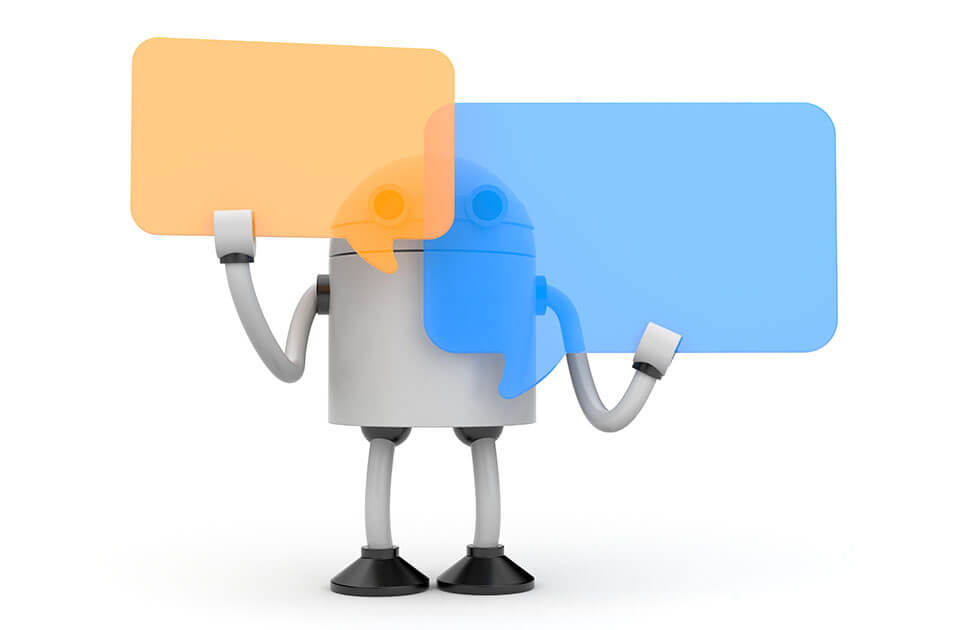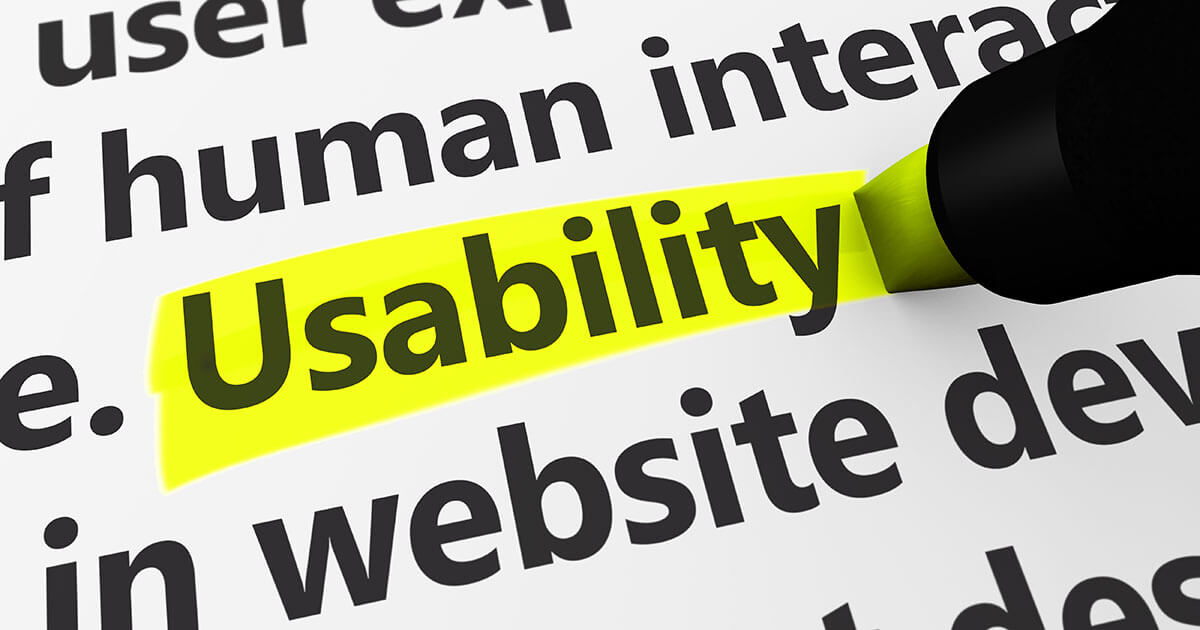Chatbots in online marketing
Online bots are everywhere: Apple uses them, Facebook has big plans for them, and Microsoft has already made a mighty mistake with them. Global online players have been busying themselves developing chatbots for years and working out how they can be used to communicate with 'real people'. Meanwhile, many projects are already quite developed and have had summaries written on them. This kind of communication technology also provides smaller companies with a lot of opportunities. We explain everything you need to know about chatbots and give an overview of the application areas and their future prognosis.
What are chatbots?
The term 'chatbot' still needs to be explained to many. Also known as 'chatterbot' or simply just 'bot', the official definition refers to it as a text-based dialogue system. Chatbots have input and output masks which they use to communicate in natural language. They basically simulate a real conversation partner.
In practice, the user communicates over a user interface where the bot automatically answers them. The systems are often connected to a mobile device’s messaging service or voice recognition (e.g. Siri from Apple). The bot acts as a natural person and gives such good answers that you could believe you were conversing with a real person.
How does a chatbot work?
The basis for each chatbot program is the database. For every request, the bot accesses the database since that’s where all the answers and recognition patterns are stored. The larger and more extensive the database is, the greater the knowledge base.
The system disassembles the questions into their individual parts before each part can be processed by the predetermined rules. Modern chatbots can detect errors in punctuation, grammar, or spelling, and correct these before answering the question. This is done with the help of a fixed pattern. The process usually takes place through Macros or another built-in scripting language.
Why do users need chatbots?
A weather app, a car sharing app, a taxi app: there’s an app for anything and everything. All the information the user obtains through various apps could be delivered all together in the future thanks to online bots – via Messenger. By integrating chatbots into messaging services, the ideal concept is created: to reach users centrally.
Instead of clicking on the weather app, users could easily ask Whatsapp’s weather bot 'Do I need an umbrella today?' and get an answer straightaway. It’s also possible to implement all further services that were previously available as apps or the mobile browser via the same user interface. This is a great opportunity for big players in the online communication world like Facebook. They obviously want users to stay on their platform and not to lose them to the weather service. If users find all the information they need on Facebook messenger, then they have no need to look elsewhere.
Eliza: the great-grandmother of chatbots
The first chatbot dates back as far as the 60s. The German-American computer scientist, Joseph Weizenbaum, developed the program 'Eliza', in order to demonstrate that it was possible for people and computers to communicate in natural language. The local program without internet access acted as a kind of virtual psychotherapist. What was surprising at the time: Eliza gave such authentic answers that the patients believed they were speaking to a real doctor and this phenomenon is known today as the 'Eliza effect'. Chatbots evolved further in the decades following. It was discovered that the more time the chatbots spent conversing and learning from these interactions and the more additional information they had at their disposal, the more authentic and accurate were the answers given.
Chatbots in customer service
Chatbots have been employed in customer service for some time to enable a faster, instantaneous contact. Customer service normally takes place over telephone or e-mail, but limited ability of staff means that this leads to delays. This is due to the users’ changing expectations since many now expect answers to their queries in real-time as opposed to waiting hours or even days for them.
In recent years, more and more companies have started using chatbots on their sites. Website visitors can ask an alleged customer service representative questions using a small chat window in the browser. What lies behind this isn’t a human, but a program. Chatbots act as advisors and answer questions about the company’s products or services. The relevant information and FAQs are stored previously in the database. Many companies use bots to shorten waiting times while at the same time reducing support costs.
Marketing opportunities: chatbots on Messenger
In the meantime, marketers have recognised that there are better places to bring online bots and users together than on their website: chat apps or messaging services. The forerunner in this regard is Kik. 40% of US teens and young adults use Kik Messenger.
Kik recently opened its bot platform for companies. Companies can send their own chatbots to communicate with users and the bots act as representatives for the brand. When users write to them and ask questions, they usually reply with product information or tips. Many bots can also tell jokes and simulate simple conversations. The chatbot used on Vine (the video platform) sends users suitable films upon request for whatever keyword they’ve entered. The weather bot predicts when it’ll rain and other bots give makeup tips, for example.
According to Kik, 1.5 million users authorised their brand with the service in the first week of the chatbots going live. The reasoning behind it was to create independent personalities from 'lifeless' brands. By enabling a conversation, the user is more likely to perceive the brand as a friend. The online bots’ task is to converse with the user and inform them. At the same time, they offer a platform through which marketers can manipulate customers without them being aware of it. Kik bots cannot learn independently, which led to Microsoft having quite a negative experience.
How not to do it: Microsoft and the racist chatbot 'Tay'
At the beginning of 2016, Microsoft launched Tay, a chatbot with artificial intelligence on Twitter as well as other platforms - and they failed spectacularly. The conversation software was meant to expand Twitter users’ knowledge via interaction. The amount of texts and questions stored was supposed to have trained the bot so well that it would be like talking to a 14-18 year old.
Instead, the adaptive chat robot developed into Microsoft’s worse nightmare in less than 24 hours. Tay learnt swear words and delivered racist, inflammatory language by itself. It even showed solidarity with Hitler! It was obvious Tay was using the wrong people as role models since internet trolls had been deliberately manipulating the naïve bot. Microsoft stopped the project and deleted lots of tweets. The takeaway from this project was that self-learning software is easy to influence, especially if the learning phase doesn’t take place in a closed system.
Kik is planning an authorised employee learning phase. The first step is for employees to communicate with customers. The chatbot watches this and learns from the conversation, then the hope is for it to be able to simulate natural conversations as perfectly as possible.
Chatbots in Facebook Messenger
With a market share of 86%, Facebook is by far the strongest social media site in the world. Marketers recognised the potential of this channel from early on and therefore have it as their core social media marketing strategy. Facebook Messenger also looks promising for online marketing.
New chatbots APIs (interfaces) and the associated message automation is intended to help companies continue to reach customers through the chat and generate revenue directly there. On top of communicating in text form, the bots should also be able to display images and descriptions of products, and enable customers to make reservations and purchases via Facebook Messenger. Some companies have already started using Messenger and conduct their customer service, live ticker, or ordering service there. Here are three examples of how companies used Facebook Messenger for marketing purposes:
KLM: boarding pass und updates via Messenger
KLM is one of the first permanent partners of Facebook in terms of Messenger marketing. In 2015 the airline published its 'Business on Messenger'. The Facebook chat previously served as a customer service for the airline guests and the idea was to then add additional service features. With the present service, you can store boarding cards in the chat and receive check-in reminders, flight changes, and delays via Messenger. The live chat feature gives customers the opportunity to ask questions and address requests directly.
Uber: order a car over a messaging service
Uber was founded in 2009 and is very well known in the US and UK. Since 2016 customers have been able to book rides via Facebook Messenger. The service can be used independently from the Uber app. The booking feature is also available within conversations of two or more users. The program shows arrival times and estimated driving costs directly in the chat.
Skyscanner: compare flights, hotels, and car hire
Skyscanner is the first travel search engine to officially launch a Facebook Messenger bot. By visiting Skyscanner’s Facebook page and sending them a private message, you’re put in contact with the bot. Just type in a destination or simply write 'anywhere' to start searching. You then receive several flight suggestions depending on your departure airport. Once you’ve found a flight that suits you, the bot will send you a link so you can visit Skyscanner’s website and book your flight from there.
The future: forecast and outlook
Chatbots are a clear trend in the advertising industry and they still have a lot of potential. They allow you to target different groups, especially over messenger services, which already have millions of users. It’s clear that mobile devices dominate the online market because more and more people are using internet on their mobile devices than on their PCs.
The idea of Messenger bots is to target customers exactly where they can be found on a daily basis – on a tablet or smartphone in Facebook Messenger or WhatsApp. These instant messaging services could be used as universal service apps in the future. The fast response time and the ability to provide real-time solutions and answers, opens up new revenue opportunities for companies.









